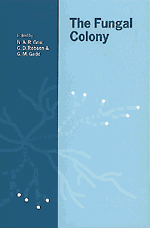Book contents
- Frontmatter
- Contents
- List of contributors
- Preface
- 1 Self-integration – an emerging concept from the fungal mycelium
- 2 Nutrient translocation and electrical signalling in mycelia
- 3 Colony development in nutritionally heterogeneous enviromnents
- 4 Circadian rhythms in filamentous fungi
- 5 Growth, branching and enzyme production by filamentous fungi in submerged culture
- 6 Metabolism and hyphal differentiation in large basidiomycete colonies
- 7 Role of phosphoinositides and inositol phosphates in the regulation of mycelial branching
- 8 Stress responses of fungal colonies towards toxic metals
- 9 Cellularization in Aspergillus nidulans
- 10 Genetic control of polarized growth and branching in filamentous fungi
- 11 Mating and sexual interactions in fungal mycelia
- 12 Genetic stability in fungal mycelia
- 13 Nuclear distribution and gene expression in the secondary mycelium of Schizophyllum commune
- Index
2 - Nutrient translocation and electrical signalling in mycelia
Published online by Cambridge University Press: 22 January 2010
- Frontmatter
- Contents
- List of contributors
- Preface
- 1 Self-integration – an emerging concept from the fungal mycelium
- 2 Nutrient translocation and electrical signalling in mycelia
- 3 Colony development in nutritionally heterogeneous enviromnents
- 4 Circadian rhythms in filamentous fungi
- 5 Growth, branching and enzyme production by filamentous fungi in submerged culture
- 6 Metabolism and hyphal differentiation in large basidiomycete colonies
- 7 Role of phosphoinositides and inositol phosphates in the regulation of mycelial branching
- 8 Stress responses of fungal colonies towards toxic metals
- 9 Cellularization in Aspergillus nidulans
- 10 Genetic control of polarized growth and branching in filamentous fungi
- 11 Mating and sexual interactions in fungal mycelia
- 12 Genetic stability in fungal mycelia
- 13 Nuclear distribution and gene expression in the secondary mycelium of Schizophyllum commune
- Index
Summary
Nutrient translocation in fungi has recently been covered in several reviews (Cairney, 1992; Boddy, 1993; Jennings, 1994; Cairney & Burke,1996). This chapter adds some new results and discusses nutrient translocation and electric signalling as parts of the integration of activities within the fungal mycelium. Some parts of the chapter are rather speculative but this is meant both to provoke the reader to come up with better ideas and to encourage more people to start research into the subjects of this chapter.
Discussion of definitions: colony and mycelium. A suggestion for using the terms Functional Mycelium Unit and Genetic Mycelium Unit
What is a fungal colony and what is a fungal mycelium? According to Ainsworth & Bisby's Dictionary of Fungi (Hawksworth et al., 1995) a fungal mycelium is ‘a mass of hyphae’ and a fungal colony is ‘a group of hyphae which, if from one spore, may be one individual’. The definitions given by Jennings & Lysek (1996) are ‘ Mycelium = network of hyphae’ and ‘ Colony = the coherent mycelium of one origin’. However, Rayner argues that the mycelium is a functional unit, an individual (Rayner, 1991). It seems we ought to see the mycelium and the fungal colony as they have been discussed historically, as a mixture of two distinctly different concepts.
Genetically identical hyphae occupying a continuous space, the Genetic Mycelium Unit (GMU).
The network of functionally integrated hyphae that forms an individualistic organism, the Functional Mycelium Unit (FMU).
- Type
- Chapter
- Information
- The Fungal Colony , pp. 25 - 48Publisher: Cambridge University PressPrint publication year: 1999
- 15
- Cited by

